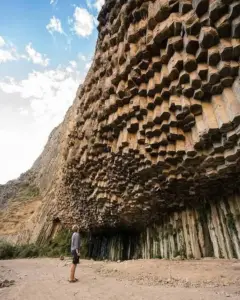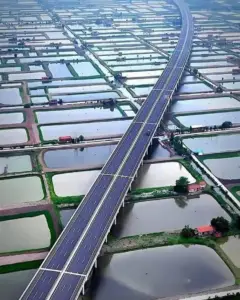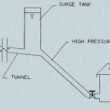Nestled amidst the rugged, awe-inspiring terrain of China’s Xinjiang Uyghur Autonomous Region, the Guozigou Bridge stands as a testament to human ingenuity and engineering prowess. This magnificent structure, a vital artery of the G30 Lianyungang-Khorgas Expressway, gracefully spans the once-impassable Guozigou Valley, connecting previously isolated communities and transforming regional transportation. More than just a bridge, it represents a feat of modern engineering, a symbol of progress, and a breathtaking spectacle that harmonizes seamlessly with the dramatic landscape surrounding it. Its construction presented formidable challenges, from the complex geological conditions to the region’s extreme weather, yet the successful completion of the Guozigou Bridge stands as a powerful example of human perseverance and the transformative potential of infrastructure development.

Introduction: Bridging the Gap in Xinjiang’s Rugged Terrain
- Connecting Isolated Communities: The Guozigou Bridge, a masterpiece of modern engineering, stands as a symbol of progress and connectivity in China’s Xinjiang Uyghur Autonomous Region.
- A Vital Link in the G30 Highway: This awe-inspiring structure forms a crucial part of the G30 Lianyungang-Khorgas Expressway, a major artery that traverses the vast and challenging terrain of western China.
- Overcoming Geographical Barriers: The bridge’s construction has significantly reduced travel times and facilitated the transportation of goods and people across the once-impassable Guozigou Valley.
Engineering Excellence: Design and Construction
- A Cable-Stayed Wonder: The Guozigou Bridge is a cable-stayed bridge, a design renowned for its strength, stability, and aesthetic appeal.
- Soaring Heights: The bridge towers above the valley floor, with its highest point reaching an impressive 209.5 meters (687 feet).
- A Main Span of 360 Meters: The bridge’s main span stretches an impressive 360 meters (1,180 feet), allowing it to gracefully traverse the deep gorge below.
- Two Towering Towers: Two massive H-frame towers, standing at 215.5 meters (707 feet) and 209.5 meters (687 feet), provide support for the bridge deck.
- An N-Shaped Truss Structure: The bridge deck is constructed using a robust N-shaped truss structure, ensuring its ability to withstand heavy loads and extreme weather conditions.
- Spiral Approach: The bridge’s unique spiral approach, featuring a loop and tunnel, allows vehicles to navigate the steep descent into and ascent out of the valley.
- A Symphony of Engineering and Nature: The bridge’s elegant design harmonizes with the surrounding landscape, creating a stunning visual spectacle.
Challenges and Triumphs: Overcoming the Odds
- Conquering Rugged Terrain: The construction of the Guozigou Bridge presented numerous challenges due to the region’s rugged terrain and complex geological conditions.
- Extreme Weather Conditions: The bridge had to be designed to withstand extreme temperatures, strong winds, and seismic activity, all of which are common in the region.
- Innovative Construction Techniques: Engineers employed innovative construction techniques and materials to overcome these challenges and ensure the bridge’s long-term stability and safety.
- A Testament to Human Ingenuity: The successful completion of the Guozigou Bridge stands as a testament to the ingenuity and perseverance of the engineers and construction workers involved.
Economic and Social Impact: Transforming the Region
- Boosting Regional Development: The Guozigou Bridge has played a significant role in boosting economic development in the region by improving transportation and trade.
- Connecting Communities: The bridge has connected previously isolated communities, providing them with access to essential services and opportunities.
- Facilitating Tourism: The bridge has also facilitated tourism in the region, allowing visitors to explore the stunning natural beauty of Xinjiang.
- Improving Living Standards: By improving transportation and access to resources, the bridge has contributed to raising the living standards of local residents.
A Scenic Marvel: Breathtaking Views
- Panoramic Vistas: The Guozigou Bridge offers breathtaking panoramic views of the surrounding mountains, valleys, and forests.
- A Photographer’s Paradise: The bridge has become a popular destination for photographers and nature enthusiasts, who come to capture its stunning beauty.
- A Symbol of Xinjiang’s Beauty: The Guozigou Bridge not only serves as a vital transportation link but also as a symbol of Xinjiang’s natural beauty and engineering prowess.
The Guozigou Bridge in Numbers:
- Total Length: Approximately 700 meters (2,300 feet)
- Main Span: 360 meters (1,180 feet)
- Height: 209.5 meters (687 feet)
- Towers: Two H-frame towers, 215.5 meters (707 feet) and 209.5 meters (687 feet)
- Cost: Estimated at over 2.39 billion yuan (approximately 340 million USD)
- Completion Date: 2011
A Legacy of Innovation and Progress
- A Landmark Achievement: The Guozigou Bridge is a landmark achievement in civil engineering, showcasing the capabilities of modern bridge design and construction.
- A Symbol of China’s Development: The bridge stands as a symbol of China’s rapid development and its commitment to improving infrastructure in even the most remote regions.
- Inspiring Future Generations: The Guozigou Bridge will continue to inspire future generations of engineers and serve as a reminder of the power of human ingenuity and perseverance.
Conclusion: A Bridge to the Future
- More Than Just a Bridge: The Guozigou Bridge is more than just a bridge; it is a symbol of hope, progress, and connectivity.
- Bridging the Gap: It has bridged the gap between isolated communities and the rest of the world, opening up new opportunities and possibilities for the people of Xinjiang.
- A Lasting Legacy: The Guozigou Bridge will leave a lasting legacy, not only as a marvel of engineering but also as a testament to the human spirit’s ability to overcome challenges and build a better future.
Additional Information:
- The Guozigou Bridge is located in the Ili Kazakh Autonomous Prefecture of Xinjiang, China.
- The bridge is part of the G30 Lianyungang-Khorgas Expressway, a major east-west highway that connects China with Central Asia.
- The bridge is situated in a scenic valley known for its natural beauty, with snow-capped mountains, lush forests, and crystal-clear rivers.
- The construction of the bridge involved the use of advanced engineering techniques and materials, including high-strength steel and reinforced concrete.
- The bridge is designed to withstand extreme weather conditions, including temperatures as low as -40 degrees Celsius and winds of up to 100 kilometers per hour.
- The bridge has won numerous awards for its innovative design and construction.
The Guozigou Bridge stands as a symbol of human ingenuity and perseverance, a testament to the power of engineering to overcome geographical barriers and connect communities. It is a vital link in the G30 highway, facilitating transportation and trade, and a scenic marvel, offering breathtaking views of the surrounding landscape. The bridge’s legacy will continue to inspire future generations of engineers and serve as a reminder of the transformative impact of infrastructure development.




















